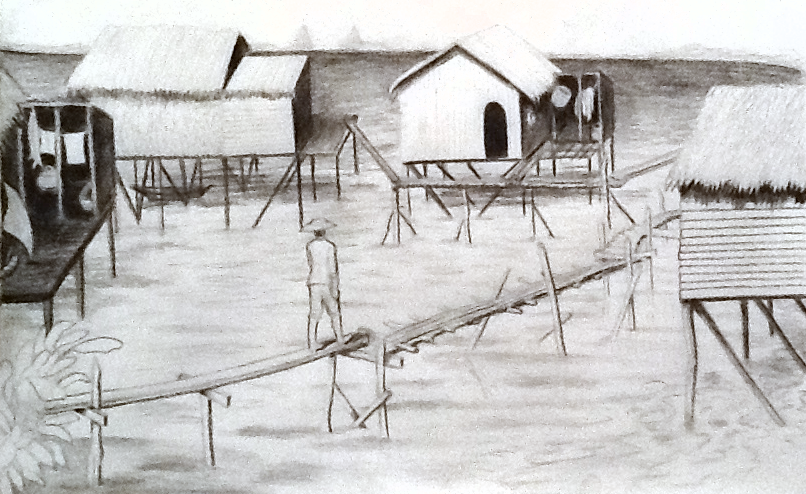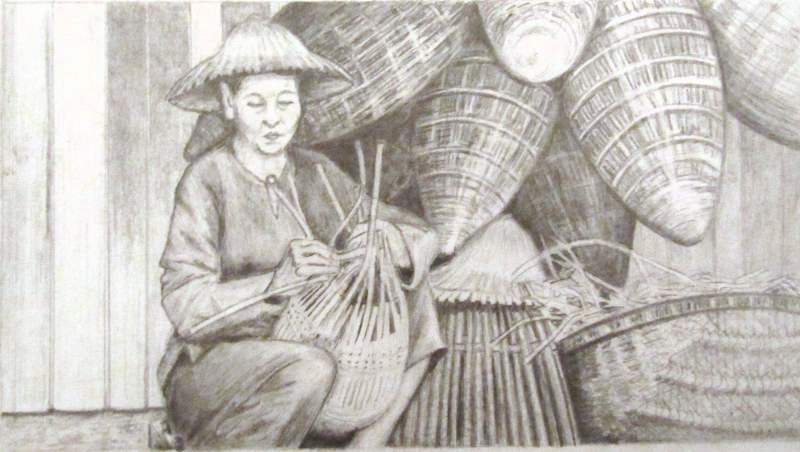Seta

Just south of Moru Kel and the docks, a series of shacks rise from the water on stilts. This collection of a couple dozen structures is simply referred to as the Seta stilt village, though it hardly qualifies as a village. The crude homes are sided in wood planks and have thatched roofs. They have no true floors, only loose boards laid atop the logs that support the structure. Next to each shack, an open shed serves as kitchen, work area, and storage. The Seta build their cookfires in metal braziers and hang pots over them from tripods, right on the wooden boards next to their wooden homes. The logs and boards stay damp, from the sea mist and are not prone to catching fire. Still, it is disconcerting to see these open fires so close to them. The Seta are a native group of humans who have lived in the area for centuries. Some say they are the descendants of the people who once inhabited Skandara, I dare you to say that to Ranga’s face, old man.though it seems highly unlikely that these simple people have any connection whatsoever to the highly civilized Urek Empire.
 The Seta have a meager existence, surviving on food they forage, fish, and hunt. A very few catch or gather enough to sell at market, but many Seta never set foot in Moru Kel at all. This is astonishing, as dozens of them live in a collection of huts that just out of the water, on stilts, and are located within sight of the southern docks. Even those who live in their larger village at the mouth of the Kilpo River, called Maringa, are just an hour’s walk from the city. Yet Seta keep largely to themselves, and most seem satisfied to merely exist, with only the sport of kite fighting and primitive songs and dance for entertainment. Their possessions are limited to the clothing on their backs and a few tools. Their dugout fishing boats are handed down from generation to generation.
The Seta have a meager existence, surviving on food they forage, fish, and hunt. A very few catch or gather enough to sell at market, but many Seta never set foot in Moru Kel at all. This is astonishing, as dozens of them live in a collection of huts that just out of the water, on stilts, and are located within sight of the southern docks. Even those who live in their larger village at the mouth of the Kilpo River, called Maringa, are just an hour’s walk from the city. Yet Seta keep largely to themselves, and most seem satisfied to merely exist, with only the sport of kite fighting and primitive songs and dance for entertainment. Their possessions are limited to the clothing on their backs and a few tools. Their dugout fishing boats are handed down from generation to generation.
The Seta do have a tradition of sending their young people on a coming-of-age journey called daipiki, and this has become a time for their young adults to explore the city, if they wish. Each year, scrawny Seta teens appear in Moru Kel, in their oddly cropped trousers and loose, long-sleeved shirts. Their clothing is sun-bleached to pale greys, greens, and browns, and they wear broad straw hats. They cluster together in shy, wide-eyed groups, whispering and pointing at the wonders of the city. Daipiki usually lasts for one summer season, but Seta can return to their homes for up to one year. Any Seta who does not return within a year is banished from their villages forever. As a result, most choose to return to their homes and families.
There are Seta who choose to remain in the city, unwilling to return to a primitive life after experiencing civilization. Some of these have successfully adjusted, finding ways to earn a living and earn their keep. A few have even been highly successful; the famous kite maker, Rimachi, and the spider silk clothier, Raymón, are Seta, as are the vast majority of noble kite fighters. These are the exceptions, rather than the rule. Many Seta who remain in the city make meager livings, that — to them — still allow luxury beyond their imagination. Proper clothing and bedsheets are unknown in their villages, as is proper hygiene; the only oil that touches Seta skin or hair is fish oil! Imagine never having a proper ochala butter rub or living with hair dried by sea salt! To their credit, the Seta who stay in Moru Kel quickly embrace trips to the barber and spa, as well as fragrant oils.
Not all of the Seta who stay in the city are able to adjust. Some do wind up Adrift. In fact a disproportionate number of the Adrift are Seta. This isn’t surprising, as the Seta have no understanding of civilization, no education, and few skills. Most speak little or no Urek when they begin daipiki. It’s actually a wonder so many of them can pick up the language and customs in a single season. Still, even those who learn the language, dress, hygiene, and coiffure do not necessarily have the skills to do more than feed themselves. Without a village to support them, they are unable to function. They often become dependent on the kindness of strangers, some of whom are criminals and manipulators. Unfortunately, once the daipiki year is up, Seta can’t return to their families when they fall on hard times. This makes them even more vulnerable.
↞ Previous: Sentinels of Koros Next: The Sisters of Skura ↠